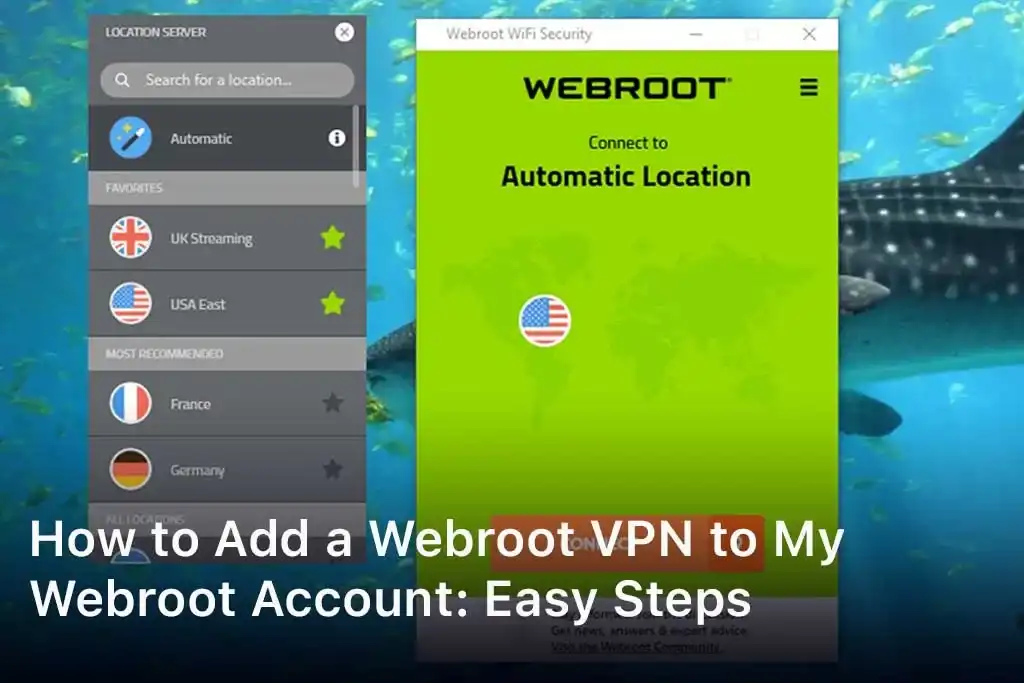Learn how to add a Webroot VPN to my Webroot account with easy-to-follow steps. This guide will help you enhance your online security and privacy seamlessly. In today’s digital age, online security is paramount. Adding a VPN (Virtual Private Network) to your Webroot account can significantly enhance your privacy and protect your data from cyber threats. Webroot offers a reliable VPN service that can be seamlessly integrated with your existing Webroot account. This article will guide you through the process of adding a Webroot VPN to your Webroot account, ensuring a secure and private online experience. What is Webroot VPN? A VPN is a tool that encrypts your internet connection, providing a secure and private tunnel for your online activities. Webroot VPN offers robust features such as anonymous browsing, protection from hackers, and access to geo-restricted content. By integrating Webroot VPN with your Webroot account, you can manage your security tools from a single platform, making it convenient and efficient. Why Add a Webroot VPN to Your Webroot Account? Adding a Webroot VPN to your Webroot account enhances your cybersecurity arsenal. It provides an additional layer of protection by masking your IP address and encrypting your internet traffic. This prevents hackers and third parties from tracking your online activities. Moreover, it allows you to access content that may be restricted in your region, providing a more open and secure internet experience. How to Add a Webroot VPN to My Webroot Account: Easy Steps Adding a Webroot VPN to your Webroot account is a straightforward process. Follow these easy steps to enhance your online security and privacy. Step 1: Purchase a Webroot VPN Subscription To add a Webroot VPN to your Webroot account, you first need to purchase a subscription. Visit the Webroot website and choose a VPN plan that suits your needs. Once you have completed the purchase, you will receive an activation code. Step 2: Log in to Your Webroot Account Next, log in to your Webroot account using your credentials. If you do not have an account, you will need to create one by providing your email address and setting a password. Step 3: Navigate to the VPN Section After logging in, navigate to the VPN section within your Webroot account dashboard. This section is where you can manage your VPN settings and activate your VPN subscription. Step 4: Enter Your Activation Code In the VPN section, you will see an option to enter your activation code. Enter the code you received after purchasing your subscription and click “Activate.” This will link your VPN subscription to your Webroot account. Step 5: Download and Install Webroot VPN Once your subscription is activated, you will be prompted to download the Webroot VPN software. Download and install the software on your device. Follow the on-screen instructions to complete the installation process. Step 6: Log in to Webroot VPN After installation, open the Webroot VPN application and log in using your Webroot account credentials. This will enable you to access all the VPN features and settings. Step 7: Configure Your VPN Settings Once logged in, you can configure your VPN settings according to your preferences. This includes choosing your preferred server location, enabling auto-connect, and adjusting security settings. Step 8: Connect to Webroot VPN Finally, connect to the Webroot VPN by clicking the “Connect” button in the application. Your internet connection will now be encrypted, and your IP address will be masked, ensuring a secure and private browsing experience. Benefits of Using Webroot VPN Enhanced Security Webroot VPN encrypts your internet traffic, providing a secure connection that protects your data from hackers and cybercriminals. Privacy Protection By masking your IP address, Webroot VPN ensures that your online activities remain private and anonymous. Access to Geo-Restricted Content Webroot VPN allows you to bypass geographical restrictions, giving you access to content that may be blocked in your region. Easy Integration Integrating Webroot VPN with your Webroot account makes it easy to manage all your security tools from a single platform. Troubleshooting Common Issues VPN Connection Problems If you encounter issues connecting to the Webroot VPN, try the following steps: Ensure your internet connection is stable. Restart the Webroot VPN application. Change the server location. Reinstall the Webroot VPN software. Activation Code Errors If your activation code is not working, double-check that you have entered it correctly. If the issue persists, contact Webroot support for assistance. Slow Internet Speeds If you experience slow internet speeds while using the Webroot VPN, try connecting to a different server. Some servers may be faster than others depending on your location and network traffic. FAQs What is a Webroot VPN? A Webroot VPN is a Virtual Private Network service provided by Webroot that encrypts your internet connection, enhancing your online security and privacy. How do I purchase a Webroot VPN subscription? You can purchase a Webroot VPN subscription by visiting the Webroot website and selecting a plan that suits your needs. After purchasing, you will receive an activation code. Can I use Webroot VPN on multiple devices? Yes, Webroot VPN can be used on multiple devices. Check your subscription plan for details on the number of devices supported. How do I activate my Webroot VPN subscription? To activate your Webroot VPN subscription, log in to your Webroot account, navigate to the VPN section, and enter your activation code. What should I do if my activation code is not working? If your activation code is not working, ensure you have entered it correctly. If the issue persists, contact Webroot support for assistance. How do I download and install Webroot VPN? After activating your subscription, you can download the Webroot VPN software from the VPN section of your Webroot account. Follow the on-screen instructions to install the software on your device. Can I change my VPN server location? Yes, you can change your VPN server location within the Webroot VPN application. Choose a server that best suits your needs. What should I do if my VPN connection is slow? If
Rare Photos Show Uncontacted Mashco Piro Tribe Fleeing Loggers
Rare Glimpses of the Mashco Piro Tribe in the Peruvian Amazon In a significant development, Survival International has published rare images of the Mashco Piro, an uncontacted indigenous tribe residing deep within the remote Peruvian Amazon. These images, released on Tuesday, depict several members of the tribe along the banks of a river, near areas where logging companies hold timber concessions. The increasing sightings of the Mashco Piro emerging from the rainforest in recent weeks have been attributed to their search for food and the encroaching presence of loggers. According to the local indigenous rights organization FENAMAD, this reclusive tribe has been compelled to move closer to more accessible areas due to the growing threat posed by logging activities. The Mashco Piro’s Recent Sightings Frequent Appearances Near the Rainforest Edges Survival International reported that the Mashco Piro were photographed at the end of June along a riverbank in the Madre de Dios region, located in southeastern Peru near the Brazilian border. Caroline Pearce, the director of Survival International, highlighted the significance of these images, noting that they reveal the presence of a substantial number of isolated Mashco Piro living just a few kilometers from the imminent logging operations. Recent sightings: Over 50 Mashco Piro individuals were recently spotted near the Yine village of Monte Salvado. Additional appearances: Another group of 17 Mashco Piro was sighted near the village of Puerto Nuevo. These sightings underscore the Mashco Piro’s increased visibility as they venture closer to areas inhabited by other indigenous groups and logging operations. The Mashco Piro’s Traditional Habitat The Mashco Piro traditionally inhabit a region situated between two natural reserves in Madre de Dios. Historically, they have rarely made contact with outsiders, including the neighboring Yine people. Their recent appearances mark a significant deviation from their usual reclusive behavior. The Impact of Logging on the Mashco Piro Encroachment of Logging Concessions Several logging companies hold timber concessions within the territory inhabited by the Mashco Piro. One such company, Canales Tahuamanu, has constructed over 200 kilometers (124 miles) of roads to facilitate the extraction of timber. This expansion has encroached upon the Mashco Piro’s traditional land, forcing them to move in search of safer areas and food resources. Canales Tahuamanu: The company is certified by the Forest Stewardship Council and has rights to 53,000 hectares (131,000 acres) of forests in Madre de Dios for cedar and mahogany extraction. Lack of response: A representative of Canales Tahuamanu in Lima did not respond to requests for comment regarding their operations and its impact on the Mashco Piro. Government and NGO Reports The Peruvian government reported on June 28 that local residents had observed Mashco Piro individuals along the Las Piedras river, approximately 150 kilometers (93 miles) from Puerto Maldonado, the capital of Madre de Dios. Additionally, sightings have been reported across the border in Brazil. Brazilian observations: Rosa Padilha, from the Brazilian Catholic bishops’ Indigenous Missionary Council in Acre, noted that the Mashco Piro often flee from loggers on the Peruvian side and are seen collecting Amazon turtle eggs along the beaches, leaving behind traces like turtle shells. The Mashco Piro’s Struggle for Peace A Life on the Run The Mashco Piro lead a life of perpetual movement, often fleeing from the threats posed by logging activities. Padilha described them as “a people with no peace, restless, because they are always on the run.” This constant state of displacement disrupts their traditional way of life and places them in precarious situations as they navigate the challenges of maintaining their autonomy and survival. FAQs about the Mashco Piro Tribe Who are the Mashco Piro? The Mashco Piro are an uncontacted indigenous tribe living in the remote regions of the Peruvian Amazon, primarily within the Madre de Dios region. Why are the Mashco Piro being sighted more frequently? The Mashco Piro have been emerging more often in recent weeks due to the encroachment of logging companies on their traditional lands, which has disrupted their food sources and habitat. What impact does logging have on the Mashco Piro? Logging activities have led to the destruction of the Mashco Piro’s natural habitat, forcing them to move closer to more accessible areas in search of food and safety, thereby increasing their visibility to outsiders. What measures are in place to protect the Mashco Piro? While there are some protections in place, such as the establishment of natural reserves, the presence of logging concessions within their territory poses a significant threat to their way of life. How can the international community help the Mashco Piro? Support for indigenous rights organizations, advocacy for stricter enforcement of conservation laws, and raising awareness about the plight of the Mashco Piro can contribute to their protection and preservation. Conclusion The recent sightings of the Mashco Piro tribe highlight the growing challenges they face due to the encroachment of logging activities on their traditional lands. These rare images serve as a stark reminder of the delicate balance between indigenous communities and external economic interests. The Mashco Piro’s struggle for survival underscores the urgent need for concerted efforts to protect their way of life and ensure their continued existence in the face of modern threats. Through increased awareness and proactive measures, we can contribute to safeguarding the rights and heritage of uncontacted tribes like the Mashco Piro.






